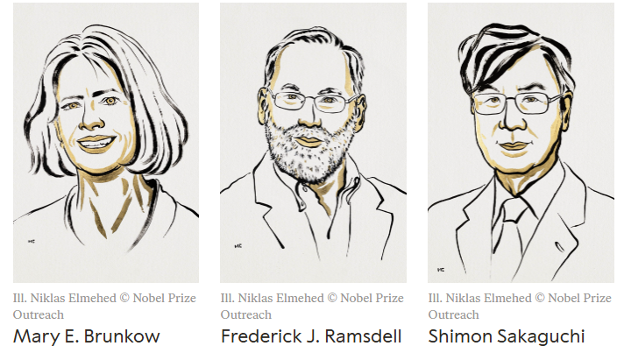About Us
For Researchers
• Lab Protocols
• Policies
• Proposals
• Strategic Plans
For Patients
Contact
October 28, 2025

The 2025 Nobel Prize in Physiology or Medicine has been awarded to Mary E. Brunkow, Fred Ramsdell, and Shimon Sakaguchi for their discoveries on peripheral immune tolerance – one mechanism by which the immune system distinguishes friend from foe.
Shimon Sakaguchi of the University of Osaka, Mary Brunkow of the Institute for Systems Biology in Seattle, and Fred Ramsdell of Sonoma Biotherapeutics seminal studies revealed critical mechanisms as to how our immune systems prevent accidental attacks against the body’s own cells, and how autoimmune diseases occur when this regulatory system is perturbed. Shimon Sakaguchi identified the subset of T-cells, expressing CD25 on their cell surfaces as protectors (known as regulatory T cells, Tregs). Mary Brunkow and Fred Ramsdell identified, first in mice then humans, a gene (FOXP3) required for Treg development.
The Immune Tolerance Network, whose mission is to translate tolerance into the clinic, has a rich history on the study of Treg’s in the context of autoimmunity, allergy, and transplantation. The ITN’s founder (and collaborator with Fred Ramsdell), Jeff Bluestone was the first to establish that Treg’s play an important role in controlling the onset of diabetes in the NOD mouse model. The ITN has developed a number of clinical trials whose aim has been to shift the balance away from effector T cell towards regulatory T cells, in type 1 diabetes, transplantation, and other autoimmune conditions.
The current ITN Director, Mark Anderson, working with Christophe Benoist and Diane Mathis, has shown that another gene, AIRE, is responsible for the removal of self-reactive T from the thymus, which is the critical step of central tolerance.
The ITN, in collaboration with many of these leaders, is working to bring the Nobel winning discovery to the clinic. Many of the ITN clinical trials have demonstrated mechanisms by which regulatory T cells can be, at least in part, re-balanced as a major step in establishing immune tolerance.
We are excited that the Nobel committee recognizes the importance of this basic science discovery and we are excited to be supported by the National Institute of Allergy and Infectious disease to translate the basic research to clinical application.
More Information
